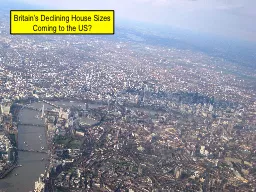PPT-Britain’s Declining House Sizes
Author : calandra-battersby | Published Date : 2018-03-13
Coming to the US Measuring Housing Affordability Median Multiple Median House PriceMedian Household Income Used by UN OECD and others Median Multiple Price to Income
Presentation Embed Code
Download Presentation
Download Presentation The PPT/PDF document "Britain’s Declining House Sizes" is the property of its rightful owner. Permission is granted to download and print the materials on this website for personal, non-commercial use only, and to display it on your personal computer provided you do not modify the materials and that you retain all copyright notices contained in the materials. By downloading content from our website, you accept the terms of this agreement.
Britain’s Declining House Sizes: Transcript
Download Rules Of Document
"Britain’s Declining House Sizes"The content belongs to its owner. You may download and print it for personal use, without modification, and keep all copyright notices. By downloading, you agree to these terms.
Related Documents














